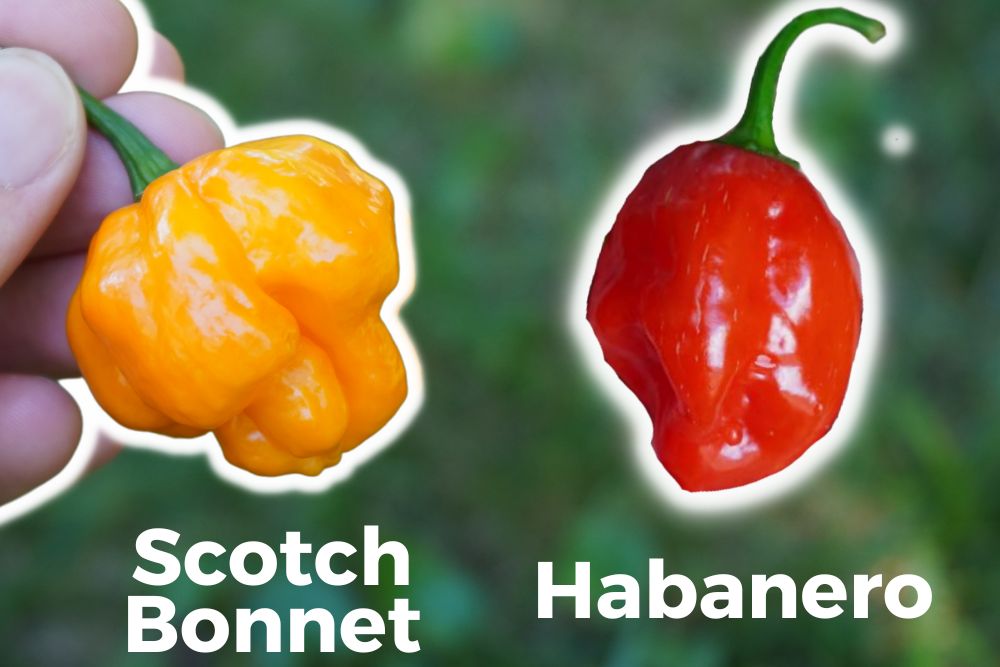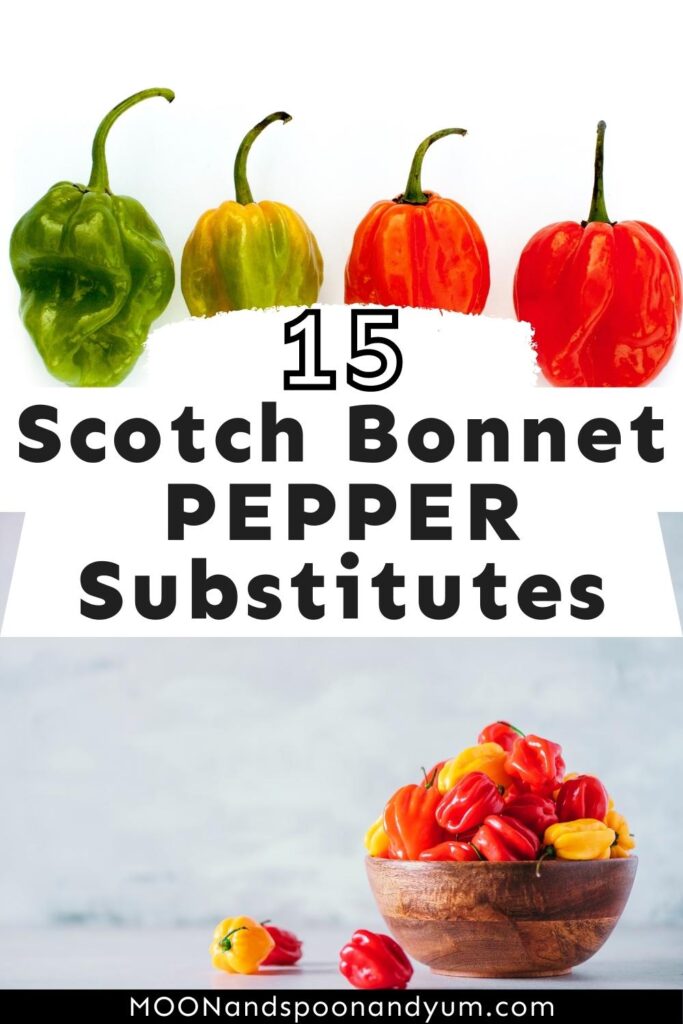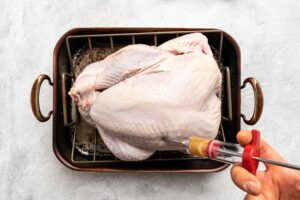Scotch Bonnet peppers pack a punch with their heat and fruity flavor. But what if you can’t find them?
Finding a suitable substitute can be a challenge. Whether you’re cooking a spicy dish or experimenting with new flavors, knowing your options is key. This blog post will explore various alternatives that can mimic the heat and taste of Scotch Bonnet peppers.
You’ll discover readily available peppers that can seamlessly replace Scotch Bonnets in your recipes. So, let’s dive in and find the perfect substitute to keep your dishes fiery and delicious.

Credit: www.culinarycareer.net
Introduction To Scotch Bonnet Pepper
The Scotch Bonnet Pepper is a popular chili pepper. It is known for its vibrant color and intense heat. This pepper is widely used in Caribbean cuisine. Its unique flavor makes it a favorite among chefs and home cooks alike.
Origin And Characteristics
The Scotch Bonnet Pepper originates from the Caribbean. It is a staple in many Caribbean dishes. The pepper gets its name from its shape. It resembles a traditional Scottish Tam o’ Shanter hat.
Scotch Bonnet Peppers are typically red or yellow. They are small but pack a punch. The heat level ranges from 100,000 to 350,000 Scoville Heat Units (SHU). This makes them one of the hottest peppers in the world.
The flavor of Scotch Bonnet is fruity and slightly sweet. This distinctive taste sets it apart from other hot peppers. It adds a unique touch to any dish.
Common Uses In Cuisine
Scotch Bonnet Peppers are essential in Caribbean cooking. They are used in a variety of dishes. Here are some common uses:
- Jerk Chicken: Adds heat and flavor to the marinade.
- Hot Sauces: Used to make fiery sauces and condiments.
- Stews and Soups: Enhances the taste of hearty dishes.
- Pickling: Pickled Scotch Bonnets are a spicy treat.
These peppers are also used in other cuisines. They can be found in African and Latin American dishes. The versatility of Scotch Bonnet Peppers makes them a valuable ingredient.

Credit: pepperscale.com
Why Substitute Scotch Bonnet Pepper
Scotch Bonnet peppers are known for their fiery heat and unique flavor. They can be overwhelming for some people. Sometimes, they might be unavailable in your local store. That’s where substitutes come in handy. Finding a suitable alternative can help maintain the balance of your dish without compromising too much on taste or spiciness.
Heat Level Considerations
The heat level of Scotch Bonnet peppers can be intense. They typically range between 100,000 to 350,000 Scoville Heat Units (SHU). This makes them one of the hottest peppers available. Using them in a dish can be too much for some people. Finding a pepper with a lower SHU can make your meal more palatable.
| Pepper | Scoville Heat Units (SHU) |
|---|---|
| Jalapeño | 2,500 – 8,000 |
| Serrano | 10,000 – 23,000 |
| Cayenne | 30,000 – 50,000 |
Jalapeño peppers are a mild alternative with a SHU range of 2,500 to 8,000. Serrano peppers are slightly hotter, ranging from 10,000 to 23,000 SHU. Cayenne peppers offer a middle ground with 30,000 to 50,000 SHU. These options provide a range of heat levels to suit different tastes.
Flavor Profile
The unique flavor of Scotch Bonnet peppers is fruity and slightly sweet. This adds a distinct taste to dishes. Finding a substitute that mimics this flavor can be challenging. Some peppers offer similar fruity notes.
- Habanero peppers are a close match. They are also fruity and sweet.
- Fresno peppers have a mild heat and a slightly fruity flavor.
- Piquillo peppers are sweet with a rich flavor, but very mild in heat.
Using these substitutes can help retain the unique taste of your dish. Habanero peppers are the closest in terms of heat and flavor. Fresno peppers and Piquillo peppers are milder but still offer the desired fruity notes.
Habanero Pepper
Finding a substitute for Scotch Bonnet pepper can be tricky. One of the best alternatives is the Habanero Pepper. It shares many similar characteristics with the Scotch Bonnet, making it a great substitute in various recipes. Let’s explore why Habanero Pepper is a suitable substitute by looking at its heat level and flavor profile.
Similar Heat Level
Both Scotch Bonnet and Habanero peppers have a high heat level. They range between 100,000 to 350,000 Scoville Heat Units (SHU). This means they are equally hot and can provide the same level of spiciness in your dishes. Here’s a quick comparison:
| Pepper Type | Scoville Heat Units (SHU) |
|---|---|
| Scotch Bonnet | 100,000 – 350,000 |
| Habanero | 100,000 – 350,000 |
Flavor Comparison
While both peppers are hot, they have distinct flavors. The Scotch Bonnet has a fruity, tropical taste. The Habanero, on the other hand, offers a slightly different flavor profile.
- Habanero peppers have a citrusy and floral flavor.
- They are less sweet compared to Scotch Bonnet.
- They add a unique depth of flavor to dishes.
Despite these differences, the Habanero’s flavor works well as a substitute. It enhances the dish with its own unique taste while maintaining the desired heat level. So, next time you need a substitute for Scotch Bonnet, remember the Habanero Pepper is a worthy contender.
Thai Chili Pepper
If you’re a fan of spicy food, then you’re probably familiar with the Scotch Bonnet Pepper. But what if you can’t find it in your local market? One excellent substitute is the Thai Chili Pepper. This fiery pepper packs a punch, similar to the Scotch Bonnet, and is widely available in most grocery stores.
Heat Intensity
The Thai Chili Pepper is known for its intense heat. It ranks between 50,000 to 100,000 on the Scoville Heat Scale. This heat level is comparable to that of the Scotch Bonnet, which ranges from 100,000 to 350,000 Scoville units. While the Thai Chili may be slightly milder, it still delivers a significant kick.
Thai Chili Peppers are small but mighty. They can easily replace Scotch Bonnets in recipes that call for a high heat level.
Usage In Dishes
Thai Chili Peppers are versatile and can be used in various dishes. Here are some ways to incorporate them into your cooking:
- Stir-fries: Add thinly sliced Thai Chili Peppers to your favorite stir-fry for an extra spicy kick.
- Sauces: Blend them into sauces for a hot and tangy flavor.
- Marinades: Use them in marinades for meats and seafood to infuse a spicy touch.
In Thai cuisine, these peppers are a staple. They are often used in tom yum soup, green curry, and papaya salad. Their distinct heat and flavor elevate these dishes to new heights.
If you prefer a milder heat, remove the seeds before using. This simple step can significantly reduce the spiciness while still providing the unique flavor of Thai Chili Peppers.
Whether you’re making a traditional Thai dish or experimenting with fusion cuisine, the Thai Chili Pepper is a fantastic substitute for Scotch Bonnet Peppers.
Serrano Pepper
In the world of peppers, the Serrano pepper stands out as a versatile choice. If you need a substitute for the fiery Scotch Bonnet, the Serrano pepper is a great option. It offers a similar flavor profile but with a milder heat level. Let’s dive into why the Serrano pepper works well as a Scotch Bonnet substitute.
Milder Heat
The Serrano pepper is known for its milder heat compared to the Scotch Bonnet. While the Scotch Bonnet ranges from 100,000 to 350,000 Scoville Heat Units (SHU), the Serrano pepper falls between 10,000 to 23,000 SHU. This makes it ideal for those who want to enjoy some spice without overwhelming their taste buds.
Flavor Notes
The flavor notes of the Serrano pepper are fresh and bright. It has a crisp, grassy taste with a hint of citrus. This makes it a suitable match for the fruity undertones of the Scotch Bonnet. The Serrano pepper can elevate dishes while maintaining a balanced flavor.
Here is a quick comparison table:
| Aspect | Scotch Bonnet | Serrano Pepper |
|---|---|---|
| Heat Level | 100,000 – 350,000 SHU | 10,000 – 23,000 SHU |
| Flavor Profile | Fruity, Tropical | Grassy, Citrusy |
- Mild Heat: Suitable for moderate spice lovers.
- Fresh Flavor: Adds brightness to dishes.
- Versatility: Works in various recipes.
Using the Serrano pepper as a substitute can enhance your cooking without the intense heat. Its fresh, citrusy notes bring a unique twist to any recipe.
Jalapeño Pepper
The Jalapeño Pepper is a popular and versatile substitute for Scotch Bonnet peppers. It provides a mild heat level and a distinct flavor. This makes it suitable for a wide range of dishes. Jalapeños are widely available and easy to work with, making them a great choice for those who prefer a less intense spice.
Mild Heat Option
Jalapeño peppers are known for their mild heat. They typically range from 2,500 to 8,000 on the Scoville scale. This makes them much milder compared to Scotch Bonnet peppers. This lower heat level allows you to enjoy the pepper’s flavor without overwhelming spiciness. Perfect for those who are sensitive to heat!
| Pepper Type | Scoville Heat Units (SHU) |
|---|---|
| Jalapeño | 2,500 – 8,000 |
| Scotch Bonnet | 100,000 – 350,000 |
Best Dishes For Use
Jalapeño peppers are incredibly versatile in the kitchen. They can be used in a variety of dishes. Here are some of the best uses:
- Salsas: Adds a mild heat and fresh flavor.
- Stuffed Peppers: Perfect for filling with cheese or meat.
- Soups and Stews: Enhances the overall flavor without overpowering.
- Salads: Adds a crunchy, spicy kick.
- Grilled or Roasted: Great as a side dish or topping.
For a quick recipe idea, try making jalapeño poppers. Simply stuff the peppers with cream cheese, wrap in bacon, and bake until crispy. It’s a crowd-pleaser!
Cayenne Pepper
Cayenne pepper is a fantastic substitute for Scotch Bonnet pepper. It is popular in many kitchens due to its accessibility and versatility. This fiery pepper can add the desired heat to various dishes. Let’s explore its heat scale and versatility in cooking.
Heat Scale
Cayenne pepper has a Scoville heat unit (SHU) rating of 30,000 to 50,000. This places it below Scotch Bonnet pepper, which ranges from 100,000 to 350,000 SHU. Despite the lower heat level, cayenne pepper still packs a punch. It can be used to add moderate heat to your dishes without overwhelming your taste buds.
| Pepper Type | Scoville Heat Units (SHU) |
|---|---|
| Scotch Bonnet | 100,000 – 350,000 |
| Cayenne Pepper | 30,000 – 50,000 |
Versatility In Cooking
Cayenne pepper is incredibly versatile in the kitchen. It is available in both fresh and dried forms. You can use it in various recipes, such as soups, stews, sauces, and marinades. It’s also a great addition to spice blends like chili powder and curry powder. Here are some ways to use cayenne pepper in cooking:
- Sprinkle a pinch on scrambled eggs for a spicy kick.
- Add to soups and stews for extra heat.
- Mix with olive oil and brush on grilled vegetables.
- Incorporate into meat rubs and marinades.
- Use in homemade hot sauce recipes.
Overall, cayenne pepper is a suitable alternative to Scotch Bonnet pepper. It provides a moderate level of heat and can be used in a wide range of dishes. Experiment with it to find the right balance of flavor and spice for your meals.

Credit: peppergeek.com
Paprika
Paprika is a popular spice derived from dried and ground peppers. It’s known for its vibrant red color and sweet flavor. Many use paprika as a substitute for the spicy Scotch Bonnet pepper. This is due to its more manageable heat level and rich taste.
Heat And Flavor Balance
Paprika offers a milder heat compared to Scotch Bonnet peppers. It brings a sweet, smoky, or even slightly pungent flavor. The heat level of paprika can vary. Sweet paprika has no heat, while hot paprika has a more pronounced kick. This balance makes it a versatile ingredient in many dishes.
Using paprika can help you control the spiciness of your dish. It ensures your recipe remains flavorful without becoming too hot. This is especially useful for those who prefer a milder spice profile.
Ideal Culinary Uses
Paprika is a great addition to a variety of recipes. Here are some ideal culinary uses:
- Seasoning for roasted vegetables
- Adding color and flavor to stews and soups
- Sprinkled on deviled eggs
- Mixed into marinades for meat
- Used in spice rubs for grilling
With its mild heat and rich flavor, paprika can enhance many dishes. It works well in recipes where you want a hint of spice without overwhelming heat.
Here is a simple comparison of Scotch Bonnet pepper and paprika:
| Aspect | Scotch Bonnet Pepper | Paprika |
|---|---|---|
| Heat Level | Very Hot | Mild to Moderate |
| Flavor | Fruity and Sweet | Sweet, Smoky, or Pungent |
| Color | Yellow, Orange, or Red | Vibrant Red |
| Common Uses | Sauces, Salsas, Marinades | Seasoning, Garnishing, Spice Rubs |
In summary, paprika is a versatile and flavorful spice. It provides a great alternative to Scotch Bonnet peppers for those who prefer less heat.
Choosing The Right Substitute
When your recipe calls for Scotch Bonnet peppers but you can’t find any, the right substitute can make a big difference. Whether you want to match the heat or the unique flavor, choosing the correct alternative is key. Let’s explore the best substitutes under different criteria.
Matching Heat Levels
Scotch Bonnet peppers are known for their intense heat. To match this, here are some alternatives:
- Habanero Peppers: These are the closest in heat. They pack a punch with a Scoville rating of 100,000 to 350,000 units.
- Thai Chili Peppers: Slightly milder, they have a Scoville rating of 50,000 to 100,000 units.
- Serrano Peppers: Much milder, with a Scoville rating of 10,000 to 23,000 units. Good for those who want less heat.
Flavor Profile Suitability
Scotch Bonnet peppers are not just hot; they have a fruity, tangy flavor. Here are some substitutes that capture this unique taste:
- Habanero Peppers: Besides matching the heat, they also have a fruity flavor. Perfect for Caribbean dishes.
- Fresno Peppers: Milder but still offer a fruity taste. Good for those who want less heat without compromising flavor.
- Jalapeño Peppers: These are less hot and slightly less fruity. They work well in a pinch.
Substitute Comparison Table
| Substitute | Heat Level (Scoville Units) | Flavor Profile |
|---|---|---|
| Habanero Peppers | 100,000 – 350,000 | Fruity, tangy |
| Thai Chili Peppers | 50,000 – 100,000 | Spicy, slightly fruity |
| Serrano Peppers | 10,000 – 23,000 | Spicy, less fruity |
| Fresno Peppers | 2,500 – 10,000 | Fruity, mild |
| Jalapeño Peppers | 2,500 – 8,000 | Earthy, mild |
Choosing the right substitute for Scotch Bonnet peppers depends on what aspect you’re aiming to match. Whether it’s the heat or the fruity flavor, there’s an option out there that fits your needs.
Frequently Asked Questions
What Is A Good Substitute For Scotch Bonnet Pepper?
A good substitute for Scotch Bonnet pepper is Habanero pepper. They have similar heat and fruity flavor.
Can I Use Jalapeño Instead Of Scotch Bonnet?
Yes, you can use Jalapeño, but it is milder. You may need to increase the quantity.
Are Scotch Bonnet And Habanero The Same?
No, they are different peppers but have similar heat levels and flavor profiles.
How Do Scotch Bonnet And Serrano Compare?
Scotch Bonnet is much hotter than Serrano. Serrano has a more grassy flavor compared to the fruity Scotch Bonnet.
Conclusion
Finding a substitute for Scotch Bonnet peppers is easier than you think. Experiment with different options like Habanero, Serrano, or Thai Chili peppers. Each offers unique heat and flavor. Adjust your choice based on the recipe’s requirements. Taste as you go to ensure the desired spice level.
Remember, the best substitute balances heat and flavor. Enjoy your spicy dishes with confidence, knowing you’ve made a great choice. Happy cooking!




